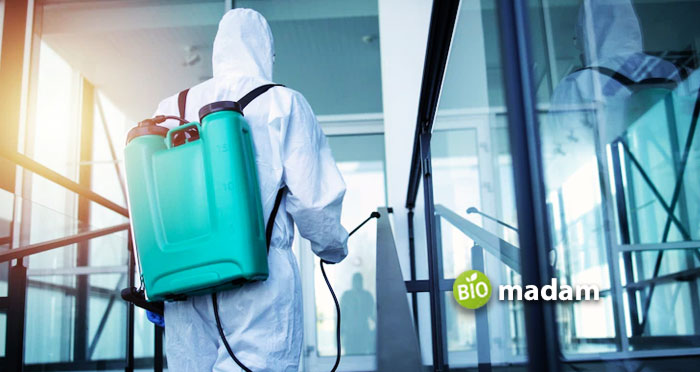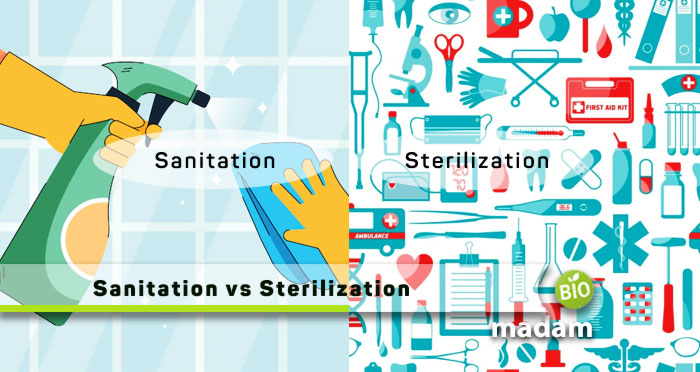Sanitation, sterilization, and disinfection are extensively used terms in different branches of biology and chemistry. They are especially more widely used in microbiology and pharmaceutics because of the need for microbe-free sterilized surfaces. Different areas in research labs and manufacturing plants require a specific level of cleanliness. Some may require sanitation, which is cleaning the surface to get rid of any dirt. On the other hand, some spaces and equipment must be sterilized using techniques that kill bacteria and pathogens.
Here are all the differences between sanitation and sterilization for better understanding.
Comparison Table
| Factors | Sanitation | Sterilization |
| Definition | Cleaning a surface or area | Removing all microbes |
| Effect on Viruses | Does not kill | Kills viruses and spores |
| Types | Environmental, ecological, container-based, on-site, etc. | Heat, filtration, steam, chemical, etc. |
| Purpose | Cleaning | Microbe-free surface |
| Application` | Homes, public areas, offices | Labs, aseptic facilities |
What is Sanitation?
Sanitation refers to keeping your surroundings clean and keeping the microbe level to a minimum.
It also involves the availability of facilities to dispose of waste to reduce contamination in habitats and ecosystems. The main purpose of sanitation is to provide hygienic living conditions to humans and prevent bacterial and viral infection transmission through feces. Some possible infections and diseases transmitted through inadequate sanitation include cholera, ascariasis, trachoma, and hepatitis.

Method of Sanitation
Sanitation requires the use of cleaning agents to clean a surface. It also involves cleaning your hands after using the restroom, keeping the surfaces clean, and washing your hands thoroughly after interacting with animals. You may use soap or detergent for the purpose.
Types of Sanitation
Sanitation in our community and ecosystem is categorized into various types depending on the sanitation methods adopted. They are:
Ecological Sanitation
Ecological sanitation, or ECOSAN, is important to ensure the safe disposal of wastes in different types of ecology, especially agriculture. It also emphasizes the use of renewable resources instead of non-renewable resources.
Environmental Sanitation
Environmental sanitation refers to controlling environmental factors connected to the transmission of diseases through viruses, bacteria, water and sewage plants, solid waste management, and industrial management.
Onsite Sanitation
Onsite sanitation refers to collecting and treating wastewater and human waste in the collected area. The applied treatment may vary among various onsite sanitation situations.
Container-Based Sanitation
Container-based sanitation is specific to services that offer safe disposal of feces for movable toilets. They collect human wastes in sealable and detachable containers transported to treatment facilities.
Community-Led Sanitation
As the name suggests, this type of sanitation involves action by the community to improve sanitation. The local government drives behavioral change in the community.
What is Sterilization?
Sterilization refers to the process of removing all forms of microorganisms, including viruses and bacteria. It does not only involve killing the active microorganisms but also bacterial endospores.
Sterilization is more difficult than disinfection and sanitation as it is challenging to kill all microorganisms; thus, achieving sterilization is more critical.

Method of Sterilization
Sterilization removes all microbes from a surface, thus it requires the use of heat, chemicals, and radiation to ensure sterility. Heating the object or surface is the most common method of sterilization. It may be achieved using a burner or lighter.
Types of Sterilization
Besides the basic method of sterilization, various types of sterilization techniques are utilized in labs. Let’s tell you about them.
Steam Sterilization
Steam sterilization is a choice of sterilization method for heat-labile substances. It is also known as moist heat sterilization. Steam sterilization is achieved in an autoclave and is an effective, fast method. The steam in the autoclave is maintained at 120 degrees for a minimum of thirty minutes. Autoclave sterilization is the safest and least toxic sterilization method.
Dry Heat Sterilization
Dry heat sterilization is the most widely used type of sterilization method. It involves the use of a hot air oven to provide heat to the material. It is the best choice for non-aqueous heat-stable preparations and powders. However, it is not the preferred method for any type of liquid or aqueous solutions.
Filtration
Filtration is another common method of sterilization used to sterilize powders, solutions, and some components of suspension. It is the quickest method to sterilize solutions that you cannot heat. Filters with a pore diameter of 0.2 microns allow bacteria removal, while candle or sintered filters remove viruses.
Chemical Sterilization
Chemical sterilization makes use of different solids, liquids, or gasses to sterilize surfaces and materials. Suitable toxic materials penetrate quickly into the material without damaging its physical and chemical properties. Ethylene oxide and carbon dioxide are the most widely utilized chemical sterilizers.
Similarities Between Sanitation and Sterilization
- Sanitation and sterilization are cleaning techniques.
- They remove microbes from the surroundings.
- Both processes may use chemicals.
- They help maintain a clean, healthy environment.
Difference Between Sanitation and Sterilization
Definition
Sanitation
Sanitation is the process of ensuring cleanliness and safe disposal of waste to reduce the chances of diseases.
Sanitization
Sanitization is the process of killing all kinds of microorganisms in a material or on a surface through different techniques.
Effect on Viruses
Sanitation
Sanitation may not kill viruses or bacterial spores present on a surface.
Sterilization
In contrast, sterilization ensures the removal of all kinds of microbes, including bacteria, archaea, viruses, etc.
Types
Sanitation
Different types of sanitation include ecological, environmental, onsite, community-led, and container-based sanitation.
Sterilization
While, sterilization is categorized based on the methods involved. They include heat sterilization, steam, filtration, chemical sterilization, etc.
Purpose
Sanitation
Sanitation is carried out to prevent the transfer of disease-causing antigens, pathogens and bacteria, especially through feces.
Sterilization
Contrarily, sterilization helps microbes from areas and surfaces that must be pathogen-free.
Application
Sanitation
Sanitation is utilized in homes, offices, and public areas to avoid the spread of germs.
Sterilization
On the other hand, sterilization is carried out in laboratories and production areas that require an aseptic environment.
The Bottom Line
Sanitation and sterilization are important cleaning techniques used in our daily life. Sanitation helps reduce the transmission of pathogen-borne diseases. Whereas sanitization kills all the pathogens to make the surface microbe-free. Sanitation is common in homes, offices, and public places, while sterilization is specific to particular areas like microbiology labs and production areas. They both play a major role in keeping the environment clean and avoiding diseases.

Hello, I would like to introduce myself to you! I am Chelsea Rogers, an experienced blog writer for science articles, holding an MPhil degree. My enthusiasm to grab the best knowledge, let it relate to botany, zoology, or any other science branch. Read my articles & let me wait for your words s in the comment section.

